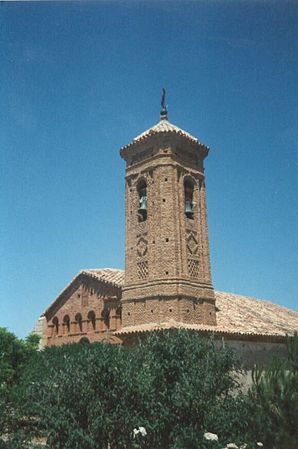Villahermosa del Campo
| Villahermosa del Campo municipality | ||
|---|---|---|
 Villahermosa del Campo - Iglesia de Santa María Magdalena
|
||
| coat of arms | Map of Spain | |

|
|
|
| Basic data | ||
| Autonomous Community : |
|
|
| Province : | Teruel | |
| Comarca : | Comarca del Jiloca | |
| Coordinates | 41 ° 7 ′ N , 1 ° 15 ′ W | |
| Height : | 955 msnm | |
| Area : | 19.2 km² | |
| Residents : | 89 (Jan. 1, 2019) | |
| Population density : | 4.64 inhabitants / km² | |
| Postal code : | 44494 | |
| Municipality number ( INE ): | 44252 | |
| administration | ||
| Website : | Villahermosa del Campo | |
Villahermosa del Campo is a place and a municipality (municipio) with only 89 inhabitants (as of January 1, 2019) in the extreme north of the province of Teruel in the autonomous region of Aragon in the eastern center of Spain . The municipality belongs to the poorly populated Serranía Celtibérica .
Location and climate
The place Villahermosa del Campo is located in the mountains of the Sierra de Cucalón on the west bank of the Río Huerva at an altitude of approx. 955 m and is approx. 104 km (driving distance) in a northerly direction from the provincial capital Teruel . Despite the altitude, the climate is temperate to warm; Rain (approx. 445 mm / year) falls over the year.
Population development
| year | 1857 | 1900 | 1950 | 2000 | 2017 |
| Residents | 228 | 237 | 316 | 70 | 94 |
The mechanization of agriculture and the task of rural small businesses and the resulting loss of jobs have to since the mid-20th century rural exodus out.
economy
Villahermosa del Campo is traditionally oriented towards agriculture, with cattle breeding playing the largest role. Craftsmen had also settled in the village. Tourism in the form of renting out holiday homes hardly plays a role.
history
Celtiberian , Roman , Visigoth and even Moorish traces have not yet been discovered. It is believed that the area was previously only used by transhumants as a summer pasture for cattle and that sedentaration only gradually took place. Until 1248 the area belonged to the Comunidad de Daroca .
Attractions
- The church of Santa María Magdalena is from rubble erected building of the 13th century with later alterations. The upper part of the bell tower (campanar) is made of bricks and shows clear echoes of the Mudejar style . The crossing of the vaulted single-nave church, which has side chapels, is domed. The main altar is the work of the Aragonese painter Juan de Huesca from 1508; In the nave (nave) there are more baroque altarpieces (retablos) .
- The Ermita de los Santos Gervasio y Protasio , a cube-shaped baroque building from around 1740, is located on the outskirts. It is a three-aisled church with a vaulted central nave and groin vaulted side aisles.
- Surroundings
- The Ermita de San Miguel stands in the middle of the fields about 5 km outside the village.
Web links
Individual evidence
- ↑ Cifras oficiales de población resultantes de la revisión del Padrón municipal a 1 de enero . Population statistics from the Instituto Nacional de Estadística (population update).
- ↑ Villahermosa del Campo - climate tables
- ^ Villahermosa del Campo - population development
- ^ Villahermosa del Campo - Church
- ^ Villahermosa del Campo - Ermita Santos Gervasio y Protasio
- ^ Villahermosa del Campo - Ermita

